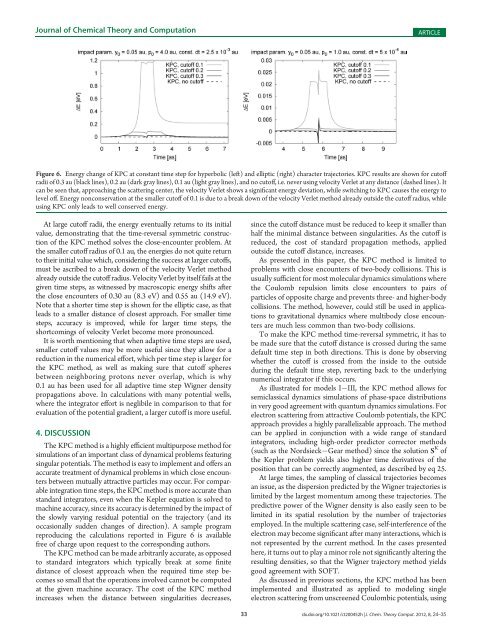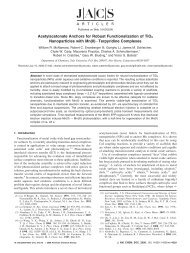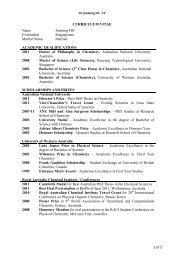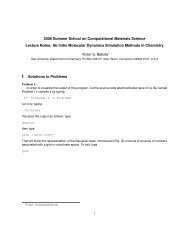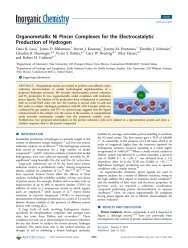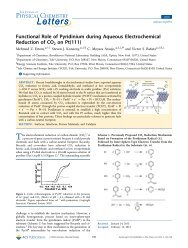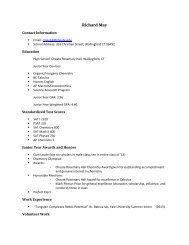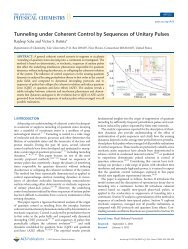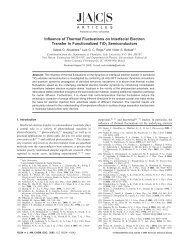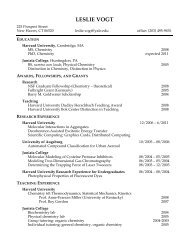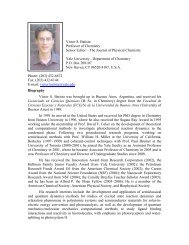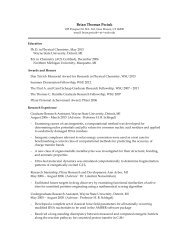Kepler PredictorâCorrector Algorithm - Yale Chemistry - Yale ...
Kepler PredictorâCorrector Algorithm - Yale Chemistry - Yale ...
Kepler PredictorâCorrector Algorithm - Yale Chemistry - Yale ...
You also want an ePaper? Increase the reach of your titles
YUMPU automatically turns print PDFs into web optimized ePapers that Google loves.
Journal of Chemical Theory and Computation<br />
ARTICLE<br />
Figure 6. Energy change of KPC at constant time step for hyperbolic (left) and elliptic (right) character trajectories. KPC results are shown for cutoff<br />
radii of 0.3 au (black lines), 0.2 au (dark gray lines), 0.1 au (light gray lines), and no cutoff, i.e. never using velocity Verlet at any distance (dashed lines). It<br />
can be seen that, approaching the scattering center, the velocity Verlet shows a significant energy deviation, while switching to KPC causes the energy to<br />
level off. Energy nonconservation at the smaller cutoff of 0.1 is due to a break down of the velocity Verlet method already outside the cutoff radius, while<br />
using KPC only leads to well conserved energy.<br />
At large cutoff radii, the energy eventually returns to its initial<br />
value, demonstrating that the time-reversal symmetric construction<br />
of the KPC method solves the close-encounter problem. At<br />
the smaller cutoff radius of 0.1 au, the energies do not quite return<br />
to their initial value which, considering the success at larger cutoffs,<br />
must be ascribed to a break down of the velocity Verlet method<br />
already outside the cutoff radius. Velocity Verlet by itself fails at the<br />
given time steps, as witnessed by macroscopic energy shifts after<br />
the close encounters of 0.30 au (8.3 eV) and 0.55 au (14.9 eV).<br />
Note that a shorter time step is shown for the elliptic case, as that<br />
leads to a smaller distance of closest approach. For smaller time<br />
steps, accuracy is improved, while for larger time steps, the<br />
shortcomings of velocity Verlet become more pronounced.<br />
It is worth mentioning that when adaptive time steps are used,<br />
smaller cutoff values may be more useful since they allow for a<br />
reduction in the numerical effort, which per time step is larger for<br />
the KPC method, as well as making sure that cutoff spheres<br />
between neighboring protons never overlap, which is why<br />
0.1 au has been used for all adaptive time step Wigner density<br />
propagations above. In calculations with many potential wells,<br />
where the integrator effort is neglibile in comparison to that for<br />
evaluation of the potential gradient, a larger cutoff is more useful.<br />
4. DISCUSSION<br />
The KPC method is a highly efficient multipurpose method for<br />
simulations of an important class of dynamical problems featuring<br />
singular potentials. The method is easy to implement and offers an<br />
accurate treatment of dynamical problems in which close encounters<br />
between mutually attractive particles may occur. For comparable<br />
integration time steps, the KPC method is more accurate than<br />
standard integrators, even when the <strong>Kepler</strong> equation is solved to<br />
machine accuracy, since its accuracy is determined by the impact of<br />
the slowly varying residual potential on the trajectory (and its<br />
occasionally sudden changes of direction). A sample program<br />
reproducing the calculations reported in Figure 6 is available<br />
free of charge upon request to the corresponding authors.<br />
The KPC method can be made arbitrarily accurate, as opposed<br />
to standard integrators which typically break at some finite<br />
distance of closest approach when the required time step becomes<br />
so small that the operations involved cannot be computed<br />
at the given machine accuracy. The cost of the KPC method<br />
increases when the distance between singularities decreases,<br />
since the cutoff distance must be reduced to keep it smaller than<br />
half the minimal distance between singularities. As the cutoff is<br />
reduced, the cost of standard propagation methods, applied<br />
outside the cutoff distance, increases.<br />
As presented in this paper, the KPC method is limited to<br />
problems with close encounters of two-body collisions. This is<br />
usually sufficient for most molecular dynamics simulations where<br />
the Coulomb repulsion limits close encounters to pairs of<br />
particles of opposite charge and prevents three- and higher-body<br />
collisions. The method, however, could still be used in applications<br />
to gravitational dynamics where multibody close encounters<br />
are much less common than two-body collisions.<br />
To make the KPC method time-reversal symmetric, it has to<br />
be made sure that the cutoff distance is crossed during the same<br />
default time step in both directions. This is done by observing<br />
whether the cutoff is crossed from the inside to the outside<br />
during the default time step, reverting back to the underlying<br />
numerical integrator if this occurs.<br />
As illustrated for models I III, the KPC method allows for<br />
semiclassical dynamics simulations of phase-space distributions<br />
in very good agreement with quantum dynamics simulations. For<br />
electron scattering from attractive Coulomb potentials, the KPC<br />
approach provides a highly parallelizable approach. The method<br />
can be applied in conjunction with a wide range of standard<br />
integrators, including high-order predictor corrector methods<br />
(such as the Nordsieck Gear method) since the solution S K of<br />
the <strong>Kepler</strong> problem yields also higher time derivatives of the<br />
position that can be correctly augmented, as described by eq 25.<br />
At large times, the sampling of classical trajectories becomes<br />
an issue, as the dispersion predicted by the Wigner trajectories is<br />
limited by the largest momentum among these trajectories. The<br />
predictive power of the Wigner density is also easily seen to be<br />
limited in its spatial resolution by the number of trajectories<br />
employed. In the multiple scattering case, self-interference of the<br />
electron may become significant after many interactions, which is<br />
not represented by the current method. In the cases presented<br />
here, it turns out to play a minor role not significantly altering the<br />
resulting densities, so that the Wigner trajectory method yields<br />
good agreement with SOFT.<br />
As discussed in previous sections, the KPC method has been<br />
implemented and illustrated as applied to modeling single<br />
electron scattering from unscreened Coulombic potentials, using<br />
33 dx.doi.org/10.1021/ct200452h |J. Chem. Theory Comput. 2012, 8, 24–35


